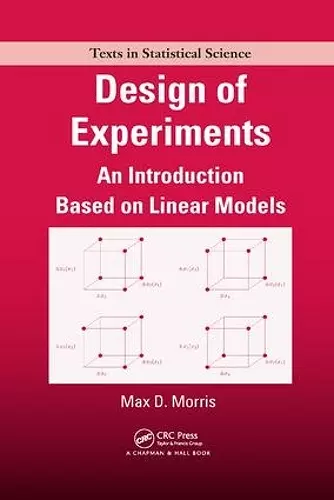Design of Experiments
An Introduction Based on Linear Models
Format:Paperback
Publisher:Taylor & Francis Ltd
Published:31st May '17
Currently unavailable, and unfortunately no date known when it will be back
This paperback is available in another edition too:
- Hardback£205.00(9781584889236)

Offering deep insight into the connections between design choice and the resulting statistical analysis, Design of Experiments: An Introduction Based on Linear Models explores how experiments are designed using the language of linear statistical models. The book presents an organized framework for understanding the statistical aspects of experimental design as a whole within the structure provided by general linear models, rather than as a collection of seemingly unrelated solutions to unique problems.
The core material can be found in the first thirteen chapters. These chapters cover a review of linear statistical models, completely randomized designs, randomized complete blocks designs, Latin squares, analysis of data from orthogonally blocked designs, balanced incomplete block designs, random block effects, split-plot designs, and two-level factorial experiments. The remainder of the text discusses factorial group screening experiments, regression model design, and an introduction to optimal design. To emphasize the practical value of design, most chapters contain a short example of a real-world experiment. Details of the calculations performed using R, along with an overview of the R commands, are provided in an appendix.
This text enables students to fully appreciate the fundamental concepts and techniques of experimental design as well as the real-world value of design. It gives them a profound understanding of how design selection affects the information obtained in an experiment.
A distinctive feature of this excellent book is that it actually focuses on how to design an experiment. … In all, an original and very useful book for students and instructors.
—Stat Papers (2014) 55:1225–1226
the author has succeeded in striking a balance between the choice of topics and depth in discussion for teaching a course. The book is written with a refreshing style and succeeds in conveying the concepts to a reader. The treatment of the subject matter is thorough and the theory is clearly illustrated along with worked examples. Other books are available on similar topics but this book has the advantage that the chapters start with the classical non-matrix-theory approach to introduce the linear model and then converts it into a matrix theory-based linear model. This helps a reader, particularly a beginner, in clearly understanding the transition from a non-matrix approach to a matrix approach and to apply the results of matrix theory over linear models further.
—Shalabh, Journal of the Royal Statistical Society, Series A, 2012
Overall, this is a book that is easy to like, with good definitions of designs, few typographical errors, and consistent, straightforward explications of the models … I can picture a lot of students using a text aimed at a broad market design course but who need to understand more about what is going on behind the curtain. Morris’ text also fills that gap very well.
—Gary W. Oehlert, Biometrics, May 2012
It is truly my pleasure to read this book … after reading this book, I benefitted by gaining insights into the modeling aspect of experimental design, and consequentially it helps me appreciate the idea of statistical efficiency behind each design and understand the tools used in data analysis. … an excellent reference book that I would recommend to anyone who is serious about learning the nuts and bolts of experimental design and data analysis techniques.
—Rong Pan, Journal of Quality Technology, Vol. 43, No. 3, July 2011
ISBN: 9781138111783
Dimensions: unknown
Weight: 376g
376 pages